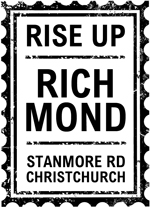Welcome to my “Get Creative Christchurch” website:
https://www.getcreativechristchurch.nz/
Our People
Identity | Well-being | Learning | Business | Community | Economy
Our Places | Shirley Community Centre
https://www.10shirleyroad.org.nz/
Creative Books | Learning Spaces
Our Places | Rise Up Richmond
http://riseuprichmond.nz/
Street Art | Sutton’s Place | Māori Heritage Park | River Bank Centre
Kai Town | River Road Park | Retreat Road Park
– April 2018: I started with this ‘project’ https://www.10shirleyroad.org.nz/imagine/
I created https://www.10shirleyroad.org.nz/, to collate my ideas/research for the rebuild of the Shirley Community Centre, as part of my submission to the Christchurch City Council 2018 Long Term Plan.
– May 2018: Presented my verbal submission to the Christchurch City Council’s 2018 Long Term Plan, for the rebuild of the Shirley Community Centre, to create a multi-cultural centre as a “Gateway to the East.”
Mayor Lianne Dalziel said “Are you saying that rather than just building back a community centre, that actually we should look at the whole of the area, and look at the whole of the needs.
So maybe what we need to be considering for the Long Term Plan is a budget that would enable a full needs analysis, and to look at what the different options are.”
– June 2018: I began to look around at our Richmond suburb, and my ideas/research became my “Rise Up Richmond” website http://riseuprichmond.nz/.
– July 2018: Regenerate Christchurch asked for feedback on their Red Zone Futures Exhibition: https://engage.regeneratechristchurch.nz/red-zone-futures-exhibition-online
Created http://riseuprichmond.nz/red-zones-future-ideas-map-by-joanna-gould/, for my Red Zone Futures ideas.
Created http://riseuprichmond.nz/otakaro-avon-river-corridor/, for my Ōtākaro Avon River Corridor feedback:
– August 2018: “Help develop the draft Arts Strategy for Ōtautahi Christchurch.
Have Your Say on the draft Christchurch City Council Arts Strategy 2018.”
https://ccc.govt.nz/culture-and-community/art-museums/toi-otautahi-christchurch-arts.
The rebuild of the Shirley Community Centre (https://www.10shirleyroad.org.nz/) was my starting point, but through my research/community mapping, I realised that there was a need for more in our communities, more opportunities for everyone to find their space/place, and to create a new identity (after the earthquakes) for our communities through creative placemaking (http://riseuprichmond.nz/).
We need to “Get Creative” in our placemaking and storytelling of our unique Māori heritage and the Christchurch earthquakes, as we invite people from throughout NZ and all the world to come and see Creative Christchurch.
Joanna Gould | joanna@getcreativechristchurch.nz
Facebook Page | Get Creative Christchurch
Facebook Group | Get Creative Christchurch Group
